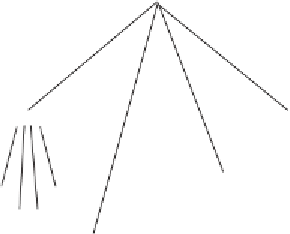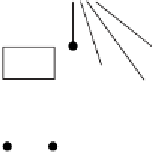Information Technology Reference
In-Depth Information
Hub
Hub
Hub
Hub
Hub
Figure 8.7
A hierarchy of hubs.
The overall structure shown in Figure 8.7 provides a hierarchy of
hubs. Each of the computers and hubs is connected by Ethernet ca
bles running 10BaseT, 100BaseT, 1000BaseT, or similar technology.
Although this hierarchical approach provides reasonable con
nectivity, each computer in the hierarchy receives the same signals,
so each must share the same logical connections and cabling. The
configuration that they form is called a
segment
, and each segment
faces the constraints regarding capacities.
To address difficulties regarding capacities, a different approach
may be employed, as illustrated in Figure 8.8, which shows two sep
arate segments, one on the left and one on the right. Each segment
has two hubs connected to local computers, and each of these hubs
is connected to a more centralized hub. Within a segment, all hubs
and workstations share the same logical cabling, and all hear the
same communications. Thus, the mechanism is the same for com
puter A to send a message to computer B or to computer H.
Computer A listens to its cable, and when the cable is free from
other activity it broadcasts its message. That material is relayed by
hubs 1, 2, and 3 to computers A, B, C, D, E, F, G, and H. Of course,
if the bridge were a hub instead, then the same message would be
sent to all other hubs and computers in the figure as well.













